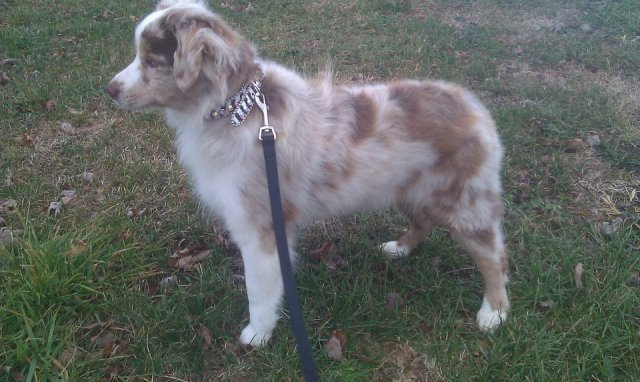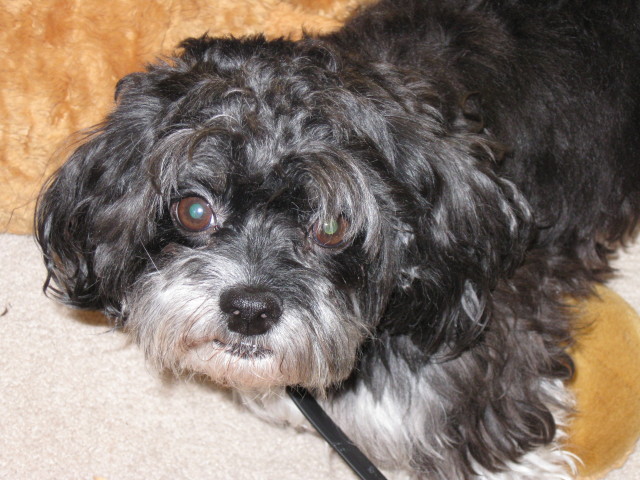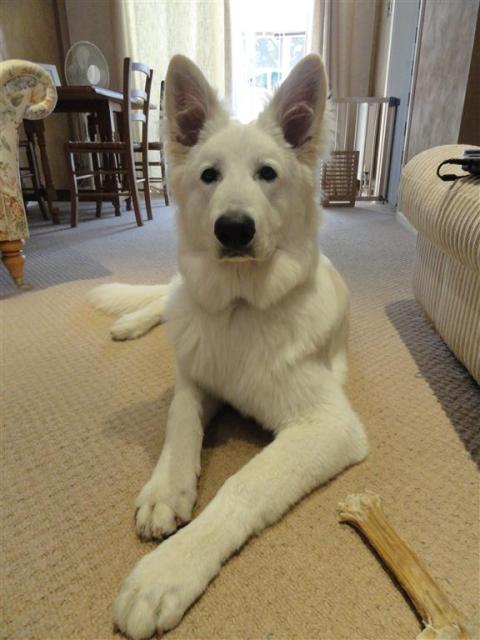QuestionA High Content Wolf Hybrid/Alaskan Husky we named Gliss was bottle fed by a man who man locked her up in a 10'x10' pen with her brother until she was one year old. She got no socialization besides him throwing food and water in every couple days. She then was rescued by a lady and we took her in 6 months later. She is now almost 2 years old and does not trust anyone except slightly me. She lives with three adult female and two adult male humans. She will come up and kiss me if no one is around and I am petting her mate but is still a bit timid with me. While at home if she sees anyone she barks consistently with her tail in between her legs (especially a male) and flees submissively if you approach. Outside of home she tries to run away submissively out of fear I assume from all humans. How can I overcome her fear of people? She has gotten a bit better since we got her 5 months ago.
AnswerThis sounds like the Jack London story, "White Fang" or the horse in "The Horse Whisperer." Needless to say the dog is severely traumatized from the abuse. In brief, bonding and trust are learned responses just as fear. Although out of print, I suggest reading "The Dog that Loved Too Much" it is an experts compilation of working with abused dogs.
The dog needs a lot of tender attention, no exposure to any traumatic conditions. Since the abuser was a male, the dog is going to be intimidated by males. It will take a long time and likely the fear/timid emotions will remain to some extent forever. I have worked with several abused dogs. One is on my DVD. Fortunately it was rescued earlier as a puppy and was not as badly abused as the incident you relate. We also took in three cats that had been kept in an attic since kittens (mother and two kittens) with no light or contact except at feeding time. It took two years before they would approach vs run and hide, and another year before they began to seek out my companionship, rub on my legs, lay in my pants, and meow to be groomed and beg at the table and lie next to me on the bed. They learned mostly by observing the other 7 cats in our house get all the goodies, and attention.
As in the two cited drama's, the dog has to approach you and learn to trust you. Once the dog trusts you and knows you are safe, it will begin to assimilate that the people you are with are OK too. You will need to be very calming and supportive when introducing other people, first at distance, then closer until someone else (especially a male) can approach and touch the dog. Once you have a relationship with the dog where the dog is comfortable around you and other people, they you need to work on confidence training to overcome the timidity and excessive timidity. This can be standard obedience training, fetch, walks on lead. The dog needs to have its own unviolated space (its den) where no one disturbes it. A place where it can sleep, have a toy, food and it is protected with only one approachable side. We bought a large dog house and put it in our house to do this for one abused dog. About 6 months later it was able to sleep in the open, eat in the open, and associate with the other dogs and cats in a normal manner. I suggest you find a local male pet professional to help in the early stages that has experience with abused dogs. One exercise I use (and you need to be confident, and very observant) is to sit or lie on the floor which is a body language communication that you are friendly and let the dog approach while not paying direct attention to the dog. Once we are friends in the less dominant position, the dog will respond while we are standing (a more dominant position).
One item we teach day one is avoid any contest play with winner/loser. That includes tug of war, teasing, rough play, or any condition where it has to compete for space, food, attention. All activities should be win/win, fun/fun. But be careful to not teach it bad habits as begging at the table, jumping on people, etc.
Being a good pack leader is going to be very important. The dog has to see you being the "boss" in your surroundings so there is no confusion about whom it can trust for care, safety, food, companionship. It is looking to you for protection until it regains its own self confidence.
Obedience training centered on reward and affection ("good dog" are the two most powerful words the dog can hear) with constant reinforcement for proper behavior is key to recovery.
Its my belief that rescued animals make better pets because they remember the abuse and appreciate more the good care we provide. They know haw bad life can be and don't want to return to that condition.
Best wishes on your new best friend.
Henry Ruhwiedel
Westwind Kennels LLC

 Designating bathroom area
Question
backyard
I have 2 medium mutts that are both b
Designating bathroom area
Question
backyard
I have 2 medium mutts that are both b
 Jumping.
Question
Stetson
I have a 8 month old, male mini
Jumping.
Question
Stetson
I have a 8 month old, male mini
 Trying to housebreak pup & she stops going
Question
Rubie Rooh
Hello - I have a 4 month old
Trying to housebreak pup & she stops going
Question
Rubie Rooh
Hello - I have a 4 month old
 Fearfull rescue dog
Question
Kiah
I have a puppymill rescue. She is a
Fearfull rescue dog
Question
Kiah
I have a puppymill rescue. She is a
 Barking at strangers
Question
Kupe
We have a 7 month old (not neutered) male
Barking at strangers
Question
Kupe
We have a 7 month old (not neutered) male